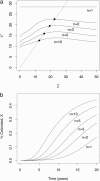Strategic interactions in multi-institutional epidemics of antibiotic resistance
- PMID: 15677330
- PMCID: PMC549473
- DOI: 10.1073/pnas.0409523102
Strategic interactions in multi-institutional epidemics of antibiotic resistance
Abstract
The increasing frequency of antibiotic resistance in hospital-acquired infections is a major public health concern that has both biological and economic causes. Here we develop conceptual mathematical models that couple the economic incentives and population biology of hospital infection control (HIC). We show that the optimal investment by a hospital for HIC changes with the proportion of patients already colonized with antibiotic-resistant bacteria (ARB) at the time of admission. As that proportion increases, the optimal behavior of a hospital is to increase spending to control ARB with low transmissibility and decrease spending on those with high transmissibility. In some cases, the global optimum investment in HIC can shift discontinuously from one that contains transmission to a do-nothing policy once the proportion already colonized at the time of admission becomes too great. We also show that investments in HIC are determined by a strategic game when several hospitals share patients. Hospitals acting selfishly and rationally will free-ride on the investments of other hospitals, and the level of free-riding should increase with the number of other hospitals in the area. Thus, in areas with many hospitals, the rational strategy for each hospital is to spend less than in areas with few hospitals. Thus, we predict that transmission rates and the prevalence of ARB should be higher in urban hospitals, for instance, compared with rural hospitals. We conclude that regional coordination and planning for HIC is an essential element of public health planning for hospital-acquired infections.
Figures




Comment in
-
The community-wide dilemma of hospital-acquired drug resistance.Proc Natl Acad Sci U S A. 2005 Feb 22;102(8):2683-4. doi: 10.1073/pnas.0500088102. Epub 2005 Feb 14. Proc Natl Acad Sci U S A. 2005. PMID: 15710874 Free PMC article. No abstract available.
References
-
- Hospital Infection Control Practices Advisory Committee (1995) MMWR Recomm. Rep. 44 (RR-12), 1-13. - PubMed
-
- National Nosocomial Infections Surveillance (2001) Am. J. Infect. Control 29, 404-421. - PubMed
-
- Mest, D. R., Wong, D. H., Shimoda, K. J., Mulligan, M. E. & Wilson, S. E. (1994) Anesth. Analg. 78, 644-650. - PubMed
-
- Bonten, M. J., Slaughter, S, Ambergen, A. W., Hayden, M. K., van Voorhis, J., Nathan, C. & Weinstein, R. A. (1998) Arch. Intern. Med. 158, 1127-1132. - PubMed
-
- Bonten, M. J., Hayden, M. K., Nathan, C., Rice, T. W. & Weinstein, R. A. (1998) J. Infect. Dis. 177, 378-382. - PubMed
MeSH terms
LinkOut - more resources
Full Text Sources
Other Literature Sources
Research Materials

